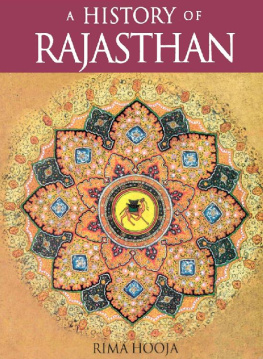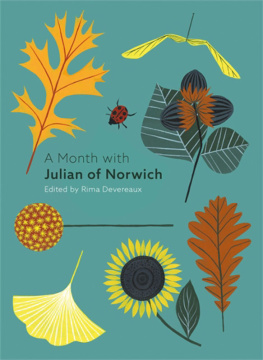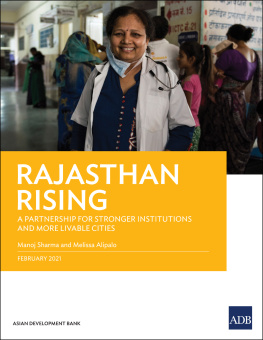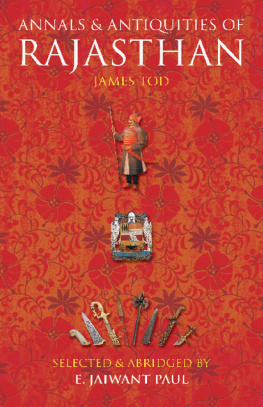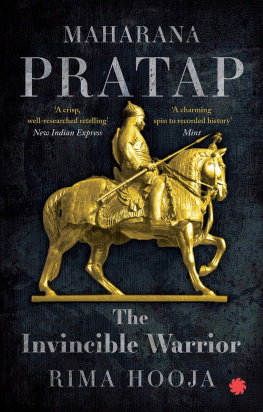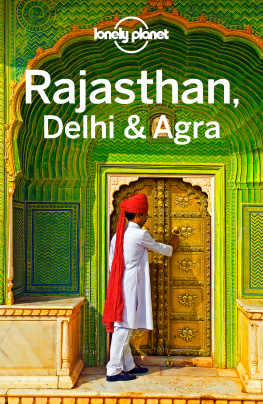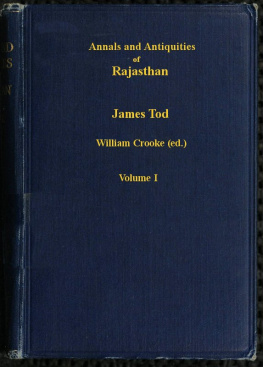A
HISTORY OF
RAJASTHAN
A
HISTORY OF
RAJASTHAN
R IMA H OOJA
Copyright Rima Hooja 2006
First Published 2006
Second Impression 2009
Published by

7/16, Ansari Road, Daryaganj
New Delhi 110 002
All rights reserved.
No part of this publication may be reproduced, stored in a retrieval system, or transmitted, in any form or by any means, electronic, mechanical, photocopying, recording or otherwise, without the prior permission of the publishers.
The author asserts the moral right to be identified as the author of this work.
Typeset in 11.5 pts. Weiss BT by
Mindways Design
1410 Chiranjiv Tower
43 Nehru Place
New Delhi 110 019
Dedicated to
Bhupendra Hooja (19222006)
In turn student leader (Lahore), radio broadcaster (AIR and BBC, London), government publicist (Delhi Administration), journalist, author, senior civil servant (IAS), writer, editor, publisher, activist, perennial seeker of knowledge, and a learned and warm hearted mentor to many.
CONTENTS
.
INTRODUCTION
R AJASTHAN, ALSO REFERRED TO AS RAJWARRA, RAETHAN AND Rajputana in the past, is synonymous in popular perception as the land of rajas and maharajas, chivalry, forts and palaces, the fabled Thar desert, and hardy folk ordinary men and women with a treasure-trove of ancient lore, music, dance, ballads and myths. It is this, and similar aspects of, the rich historical heritage that the present book on Rajasthans history has attempted to summarise and present.
While the present-day state of Rajasthan is a relatively recent entity, formed in the wake of Indian independence in 1947, the region has a very long history. As such, the book tries to cover a broad spectrum encompassing the basic political, socio-cultural and economic history of the area comprising the area of present-day Rajasthan from the earliest times to the present. It is relevant to note here that in recent years, the importance of regional studies, complementing existing mainstream history, has been recognised, and regional or local history forms part of the academic syllabi of most Indian universities. However, in the case of Rajasthan, though specialised scholarly books and short tracts in Hindi and English, covering specific topics, written by academics are available, there exists a lacuna for a comprehensive, yet easy-to-read, book on Rajasthans history aimed at both the general reader and scholar alike.
In an age where it isnt politically correct to see works with a strong chronological and dynasties-related stress, I should state at the outset that there is a strong element of both these aspects in this book! For one thing, the nature of texts and sources so far available (e.g. khyats, rasos, kavya , etc.; the numerous genealogical vamshavali and pidhivali etc., court records, epigraphs, inscribed eulogies; coins; oral traditions) make it far easier to present a certain kind of information. Such information focuses more on the elite and the merchants, traders, religious groups; the several warrior clans and their battles; the grants given to bards, priests, religious sects; the literary, architectural and cultural achievements; and so forth. Of course, there is also considerable information about land revenue etc. and work has been done in the past couple of decades on some chronological periods, covering late medieval to pre-modern and modern subaltern aspects, as well as late medieval to pre-modern and modern economic and land-related aspects. Despite such work much of it substantive there are still lacunae for many, earlier, aspects of the socio-economic, subaltern, peoples oriented etc., everyday life of the average citizen.
As such, I look at this present book as fulfilling the role of providing a basic framework of the old-fashioned political history with generous admixture of other aspects for Rajasthan through the centuries. To this, I hope to eventually add a couple of further volumes at some point in the future. In these, I will try and take up alternative approaches and subject-matters, and do better justice to the people of the past few millennia who have lived in Rajasthan.
History is much more than a mere chronological arrangement of events and incidents, however. Thus, the book has also tried to provide a general overview of aspects like the literature, religions, art and architecture, position of women, etc. all of which go into the making of history and culture. However, the limitations of space and occasionally a paucity of information have determined to a degree the amount of general socio-cultural, economic, subaltern and gender-related etc. aspects that one has been able to put into this work. Perhaps this can be resolved by another, differently oriented, book in the near future!
Furthermore, despite the not inconsiderable bulk of this work, there remain many other associated aspects of human life that have, due to space constraints as much as being outside the immediate scope of this work, remained scantily touched upon. The history of indigenous science and the development of technology in this region, for instance, have not really been examined in this book and indeed require a full separate book in itself to do justice to the subject!
To take the example of metals and metallurgy: the erstwhile princely state of Mewar has long been recognised for its mineral wealth, including abundant copper ores which began to be worked from c. third millennium BC onwards. There are also large deposits of lead and zinc in and around Zawar, about forty kms southeast of Udaipur. Zawar has been an important centre of zinc production for contemporary India, and in the 1950s the Zawar hills were described as possessing Indias richest deposits of lead, zinc and silver! Zinc production here has been carried out in recent years by Hindustan Zinc Ltd., public sector organisation. Fascinatingly, recent studies have shown that zinc smelting was known in the Zawar area at least by the fourteenth-fifteenth centuries AD, if not somewhat earlier (as is discussed further in this book). This date precedes zinc-smelting in most other parts of the world, especially Europe!
While this aspect of science and technology is looked at in this text, many others are not mainly because of constraints of space. In a different vein, but by way of further whetting the appetite of interested readers, one may also mention just one of the ingenious local methods that evolved to cope with the restrictions imposed by the climate and terrain. On display at Jaisalmers palace-museum is a device for cooling a room, which is fabricated from wood, metal and frames set with vetiver-grass ( khus ). This pre-modern cooler incorporates a manually turned spoked wooden wheel, which in turn moves small wooden fan-blades set within a large drum-like structure with wetted frames of khus on both sides. As the wheel turns, the fan-blades revolve, drawing and circulating khus cooled air through the chamber!
It is openly known that there are various accounts of different periods of the past available to us. For Rajasthan, these are in the form of scanty archaeological data, coins of kings (occasionally queens) and kingdoms, and references in various works of literature and various languages like Sanskrit, Prakrit, Persian, Apabrahmsa, Rajasthani (i.e. Dingal, Pingal) etc. The sources also take the shape of genealogies and archival records, oral traditions and travellers accounts, as well as numerous inscriptions on copper-plates grants, stone-slabs inset at wells, reservoirs and other water-structures, within caves, on the walls of temples and mosques, and at forts and palaces.




